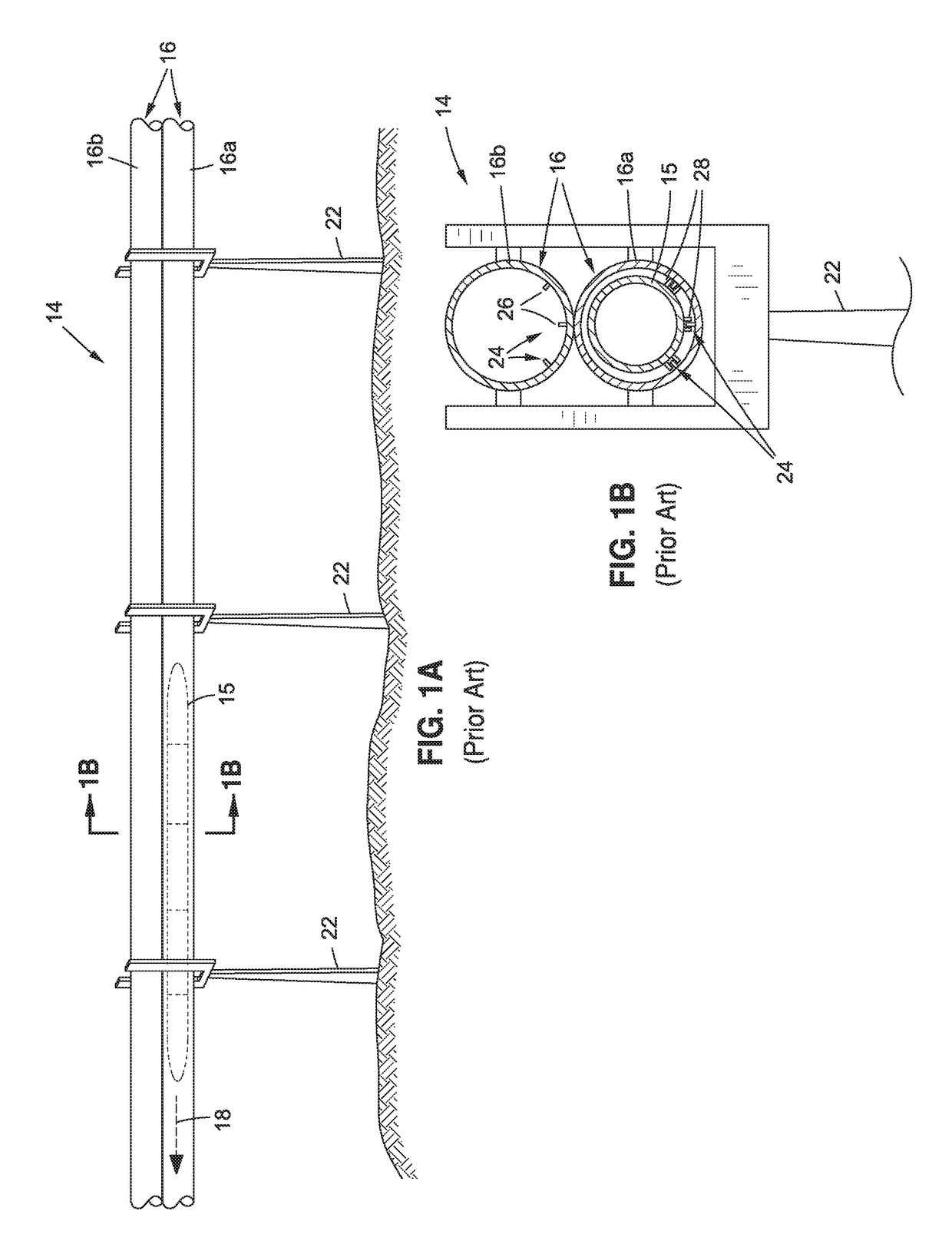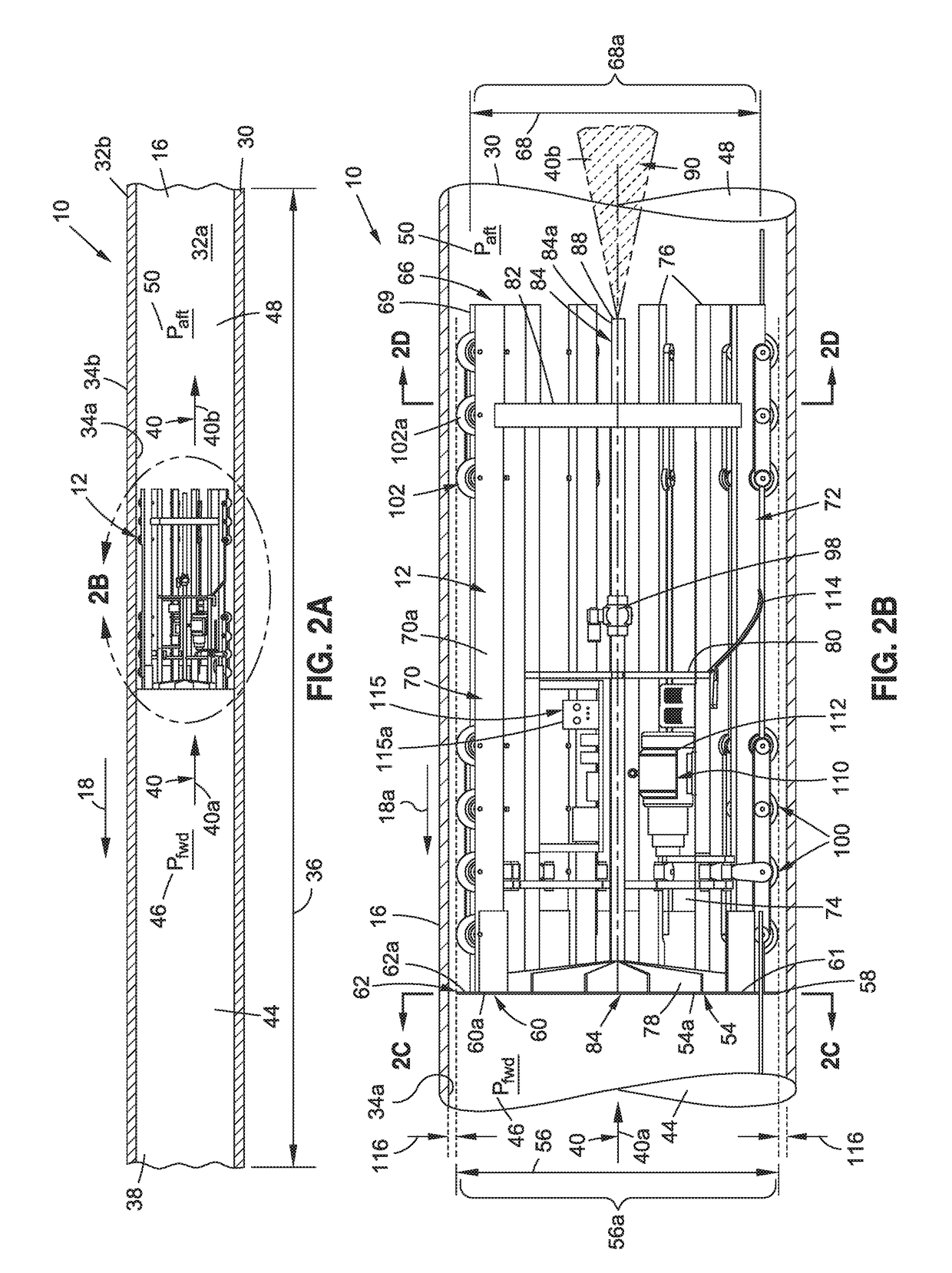Vacuum transport tube vehicle, system, and method for evacuating a vacuum transport tube
a vacuum transport tube and vacuum technology, applied in transportation and packaging, locomotives, roads, etc., can solve the problems of difficulty in evacuating the tube, creating and maintaining a vacuum, or near vacuum, in the tube, and high cost of vacuum pump equipment,
- Summary
- Abstract
- Description
- Claims
- Application Information
AI Technical Summary
Benefits of technology
Problems solved by technology
Method used
Image
Examples
example 1
[0103]FIG. 6 is a schematic illustration of a velocity 142, such as a forward velocity 142a, from 0 (zero) second to 1 (one) second, through the vacuum transport tube 16, for an embodiment of a vacuum transport tube vehicle 12, such as a car 13, of an embodiment of the vacuum tube vehicle system 10 of the disclosure. FIG. 6, as well as FIG. 2C, shows the quantities that may be used to calculate the pressures 43 (see FIGS. 7A-7B), such as the forward pressure (Pfwd) 46 and the aft pressure (Paft) 50.
[0104]The following example was prepared to illustrate the concept.
[0105]The gap area (Agap) 120 (see FIGS. 2C, 6) was the gap distance (d) 118 (see FIG. 2C) multiplied by a perimeter 35 (see FIG. 16) of the vacuum transport tube vehicle 12. For a vacuum transport tube outer diameter 31 (see FIGS. 2C, 16) equal to 14.0 feet and a gap distance 118 (see FIG. 2C) of 0.25 inches (0.020833 ft), the gap area 120 (see FIG. 2C) was 0.916 square feet.
Agap=(π)(D)(d)=(3.14159)(14.0)(0.020833)=0.916 ...
example 2
[0117]The operation of the vacuum transport tube vehicle 12 falls into three regimes, including orifice control 144 (see FIGS. 7A-13), speed control 146 (see FIGS. 7A-13), and constant pressure ratio 148 (see FIGS. 7A-13).
[0118]With respect to orifice control 144 (see FIGS. 7A-13), when starting out at ambient pressure 46a (see FIG. 3A), it is the case that using an annular gap 116 (see FIG. 2C) of only 0.25 inches results in a large delta pressure 52 (see FIGS. 11A-11B), or pressure differential, between the forward space 44, i.e., forward volume, and the aft space 48, i.e., aft volume. A large delta pressure 52, or pressure differential, may result in a large force being applied to the forward surface 60 (see FIG. 2B) of the vacuum transport tube vehicle 12 (see FIG. 2B). If a horsepower is limited to a certain value, this forces the speed of the vacuum transport tube vehicle 12, such as the first car 13a (see FIG. 4A) to be quite slow, perhaps 2 ft / sec (two feet per second) or 3 ...
example 3
[0130]With regard to speed control 146 (see FIGS. 7A-13), at some point, the orifice diameter 92 (see FIG. 2C) becomes zero, or less than zero, and the orifice 84 (see FIG. 2C) may be closed. If the annular gap 116 (see FIG. 2C) was maintained at the same value, the power required 96c (see FIG. 12A) will decrease if the speed 94 (see FIG. 16) is held constant. If one desires to maintain the same horsepower required, the speed may be increased. The speed at which this occurs was given by the following equation:
vpiston=P+(Vgap)(Pfwd) / (Pfwd)(Apiston head)=330,000+(1007.6)(2116.7) / (2116.7)(153.94)=8.932 ft / sec (feet per second)
[0131]The rest of the quantities could be calculated using the equations from Example 1.
[0132]With regard to the constant pressure ratio 148 (see FIGS. 7A-13), it may be desirable to limit the top speed of the vacuum transport tube vehicle 12. In this case, the equations from Example 1 could be used.
[0133]Now referring to FIGS. 7A-12B, FIGS. 7A-12B show the values...
PUM
 Login to View More
Login to View More Abstract
Description
Claims
Application Information
 Login to View More
Login to View More - R&D
- Intellectual Property
- Life Sciences
- Materials
- Tech Scout
- Unparalleled Data Quality
- Higher Quality Content
- 60% Fewer Hallucinations
Browse by: Latest US Patents, China's latest patents, Technical Efficacy Thesaurus, Application Domain, Technology Topic, Popular Technical Reports.
© 2025 PatSnap. All rights reserved.Legal|Privacy policy|Modern Slavery Act Transparency Statement|Sitemap|About US| Contact US: help@patsnap.com



